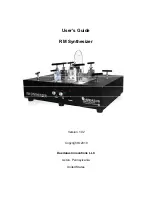
7.4.5. Flanger
Flanging works by mixing two nearly-identical signals together, with one signal delayed by
a small and gradually changing period. This produces a swept “comb filter” effect as the
delayed signal adds and subtracts from the original due to phase cancellation at multiple
frequencies simultaneously.
Control
Description
Stereo
Switches the flanger output between mono and stereo.
LP Freq
Low Pass Filter, range 1 kHz to 20 kHz. Use this to reduce the range of high-frequency content
that will enter the flanger effect. Double-click to set to the default of 10 kHz.
HP Freq
High Pass Filter, range 30 Hz to 800 Hz. This rolls off low-frequency content that the flanger
effect will receive. Double-click to set to the default of 125 Hz.
Shape
Toggles the modulation LFO between sine and triangle waveforms
Polarity
Changes flanger feedback to subtractive (negative) rather than additive
Feedback
Adds feedback for a harsher or "ringing" sound, similar to a resonant filter. Maximum is 99% to
avoid runaway feedback.
Delay
Sets the base delay frequency, which changes the spacing and frequency of the resulting comb
filter.
Depth
Sets the range of delay time that will be scanned around the base frequency. When Depth is 0,
the comb filter stays at a fixed position set by the Drive control.
Frequency
Controls the "sweep speed" of the flange effect. In Hertz mode, the range is from 0.005 to 10
Hz, or if in a Sync mode, speed of flanging is synchronized with tempo. For a description of the
Sync binary, Triplets, and Dotted options, see
.
Appears as a Mod Destination in
the Mod Matrix.
Dry/Wet
Controls the balance between the input signal and the effected signal.
Note: flanging
characteristics are strongest when there is a mix of dry and wet signals.
Arturia - User Manual CZ V - FX (Effects)
76
Summary of Contents for CZ V
Page 1: ...USER MANUAL ...
















































